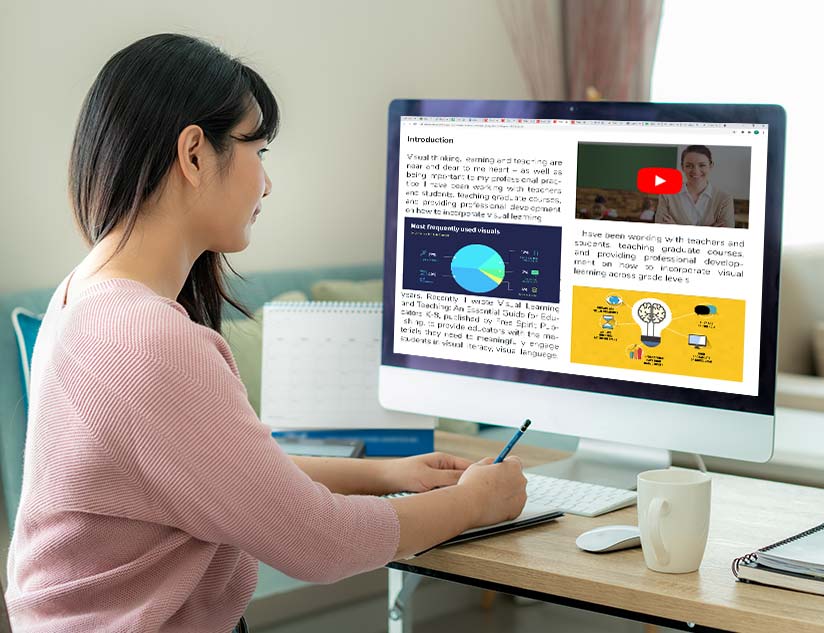The year 2017 saw a surge of edtech for schools, higher learning and skill-based learning. Metaari, earlier Ambient Insight, reported that global investments in edtech companies reached as much as $8.15 billion in 2017. Growing at a rapid pace, the edtech industry is providing solutions to capture the demands of 21st century education and academia. Having come together in a profound manner, the use of internet in schools, documentation, presentations, etc. are a proof that technology is making its place in the education sector. Technology presents a number of opportunities for schools to create more engaging and effective teaching tools in the modern-day classrooms. In the global competition for highly advanced and unique skills, the demand for refined, interactive learning platforms is gigantic.
Today’s education environment is primed for edtech adoption. EdTech, by reinventing the approaches to learning and collaboration, helps affirm and advance relationships between educators and students. It also shrinks the long-standing equity and accessibility gaps in order to make it available to all learners. It not only expands but also accelerates and amplifies the impact of effective teaching practices, encompassing everything from the simple use of computers to teaching everyday subjects in elementary schools.
Leading global campuses such as Stanford University and Carnegie Mellon University allow students to access lectures online as well as to submit homework online. California State University Northridge launched the Computer Supported Collaborative Science initiative to help science teachers in high-need Los Angeles-area schools to engage students in authentic research experiences through the use of cloud-based tools. Of course, this is just the tip of the iceberg.
The traditional academic world is transforming, with advances in technology and changing student expectations opening doors to new ways of learning and engaging with course materials. Technology and education are a great combination if used together with a right reason and vision. With technology, educators, students and parents have a variety of learning tools at their fingertips. The evolving architecture of education has enabled edtech to create efficiencies, cut costs and support new levels of standardization. Engaging with students in an innovative way so they can easily understand and digest information is the key to encourage independent learning. Thus, edtech provides a much more rewarding environment for both students and teachers.
Related Readings: Personalized Mobile Learning Solutions to Create Effective Learning Paths
EdTech – The Pros & Cons
With edtech adding value to classroom, let us look at the pros and cons of this new wave in learning.
What are the advantages for teachers?
Automated process helps save time: It is crucial for the teachers to ensure that students are able to grasp every lesson that is taught in class. The teacher is responsible for ensuring that the lessons are comprehensible and clear. EdTech simplifies things by helping teachers to plan in advance and to add new and innovative concepts to their lesson plan. Automation is another big benefit of edtech for teachers. For instance, MagicBoxTM assessments are auto-graded which leaves more time on the teacher’s hands to focus on a student’s progress.
Easier to access student data: Every child has individual needs. In order to help teachers accomplish their assigned tasks & duties on time, several startups and education technology companies now provide adaptive learning programs intended to track a student’s progress. MagicBoxTM offers cumulative class and skills reports that are generated based on the assessments. It also provides supplementing materials that can help teachers design effective lesson plans.
Allows use of flipped classroom: Technology enables teachers to flip the classroom. Teacher can focus on resolving issues and doubts in classroom rather than delivering content. Studies have shown, that use of flipped classroom in the learning process enhances students’ motivation and improves their academic performance. It has been observed that flipped classroom help students to acquire new knowledge, gain experience and improve their understanding of the subject studied. Learn more about role of flipped classrooms in our blog: Flipped Classrooms: Transforming Education and Learning
What are the benefits for students?
Automated process help save time: Edtech explicates technology in a way that the lessons become coherent and graspable. Also, the tools used can be used across the board such as to streamline grading programs as well as to send messages to students and parents about schedules, reports and changes.
Etiquettes of online communication: Edtech prepares students for the future while retaining the collaboration and social learning which is also very important.It provides students a secure and structured environment where they can use the resources of their choice to discuss, communicate and collaborate. MagicBoxTM has replicated the concept of notes sharing in its ‘Collaboration Module.’ It allows students to exchange and share notes in order to study with friends and collaboratively develop a deeper understanding of concepts.
Access to variety of information: Edtech overcomes several limitations of textbooks. For instance, with edtech students can find answers to specific questions, they can watch videos online, grasp concepts using various senses, and discuss it in class proactively. Teachers can easily look out for videos and explain its relevance. When digital capabilities like online environments are incorporated meaningfully into instruction, students have new opportunities to learn and achieve.
Designed with technology as the backdrop, students develop the art of sending mails, the different email formats, performing troubleshooting on bugs, creating visually pleasing digital presentations; edtech helps thrive in a tech-based world. It helps in developing technologically responsible citizens who are well versed with the digital landscape and can use their knowledge & expertise to develop new resources.
Issues concerning EdTech
For the students:
Conceivable distraction: Technology fascinates young minds and if boundaries are not well established in the start itself, students can overuse the resources. When edtech is introduced in any sector, it is important to implement effective sieving devices in order to stop students from creating a ruckus or from sending malware or from blocking any software. Media literacy can be quite a task since limiting technological participation is a complicated process.
Defeats human connection: In the digital era, interpersonal skills cannot be negotiated. With social media taking over the traditional form of communication, students are losing personal connect. It is believed that with edtech students will lose the ability to communicate verbally and fail to learn skills necessary for a fulfilling social life.
Brings forth inequality: Access to technology outside classroom is the luxury only a few can afford. It will always the case that students who don’t have access to tablets will have to go to library to finish their homework.
For the teachers:
Threat of edtech replacing teachers: Many tech enthusiasts roll their eyes when people voice their concerns that educational technology is a way to replace teachers in the future. The newest advances in edtech are powerful enough to deliver content, assesses, and set students on a new course of learning, all without teacher intervention. this development poses a threat when past speaks of workers getting laid off as technology replaces manpower. However teachers do much more than deliver content, teachers role might change but can never be eliminated. Technology and AI is generations away from getting to a point where they will change the role of teachers.
Perpetuates plagiarism: Students have always found ways to cheat and copy. The digital age makes it even easier as students are able to copy-paste from far-fetched places or even hire someone to complete their assignments. With each passing year, students are able to access essays, reports, class notes, tests, etc. online, making it much more difficult for teachers to know if the work their students submit is original or not.
A silver bullet for problems in education, technology is best used when it empowers teachers and students to create personalized, accessible, creative learning experiences. With edtech both teachers as well as students can benefit from more customized teaching and learning. The amalgamation of multimedia, gamification, learning apps and peer-to-peer learning platforms has not only made content immersive; it also helps to keep the students engaged. Edtech is seen to create a sturdier link between the classroom and outside. This is mainly because digital educational resources like assignments and test prep material are available at all times. However, it is critical to view edtech as means to this end, rather than an end in itself.
Contact MagicboxTM for any query regarding K-12 or corporate learning solutions and our team will schedule a free demo for you!











